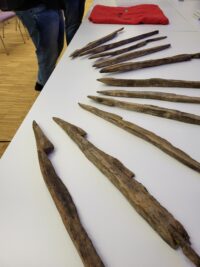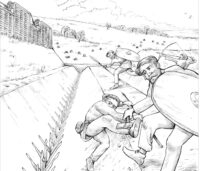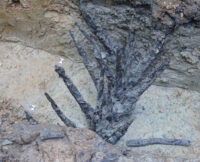 The deadly sharped wooden spikes from Roman forts unearthed near Bad Ems, Germany, have been unveiled in all their threatening glory after conservation at the Leibniz Center for Archaeology (LEIZA) in Mainz. The 23 wooden skewers have been undergoing conservation for almost three years and posed a multi-layered problem. Conservators had to stabilize the wood to keep it from drying out and shrinking or cracking. They also had remove the thick layers of sediment which were attached to the wood with unusual strength.
The deadly sharped wooden spikes from Roman forts unearthed near Bad Ems, Germany, have been unveiled in all their threatening glory after conservation at the Leibniz Center for Archaeology (LEIZA) in Mainz. The 23 wooden skewers have been undergoing conservation for almost three years and posed a multi-layered problem. Conservators had to stabilize the wood to keep it from drying out and shrinking or cracking. They also had remove the thick layers of sediment which were attached to the wood with unusual strength.
The spikes were discovered in a 2019 excavation at the site of two previously unknown early imperial military camps on the river Lahn. Found in a v-shaped trench still in their original upright or angled positions, ready to impale an unwary attacker, the carved wooden spikes were preserved in exceptional condition by the waterlogged clay soil. Known from ancient sources like Julius Caesar’s Gallic Wars, these are the first (and so far only) examples of this type of defensive barrier ever found.

 Dubbed pila fossata (ditch spears) by the archaeologists (there are no specific names for them in the ancient sources), they were made of oak and were an average of 65 cm (26 inches) long and 4.5-6cm (1.7-2.3 inches) in diameter. They were sharped on both ends and had two notches, one cut out of the bottom and the other at the top on the opposite side of the stake, giving it mean barb to look extra threatening and making it harder for anyone who had the misfortune to fall onto it to extricate themselves than a plain sharpened spike would be. The bottom notch appears to have been used to hammer it into the dense clay soil, as the wood fibers in the notch were squashed down from the impact. The top notch was cut into the opposite side of the stake. They were installed angled outwards, upwards and inwards, bristling in all directions at once much like the barbs on barbed wire. Between the pila were thin rods or branches of brushwood extending lengthwise along the trench. They may have been tossed into the ditch when the camp was dismantled and their defenses buried to prevent the enemy from using them.
Dubbed pila fossata (ditch spears) by the archaeologists (there are no specific names for them in the ancient sources), they were made of oak and were an average of 65 cm (26 inches) long and 4.5-6cm (1.7-2.3 inches) in diameter. They were sharped on both ends and had two notches, one cut out of the bottom and the other at the top on the opposite side of the stake, giving it mean barb to look extra threatening and making it harder for anyone who had the misfortune to fall onto it to extricate themselves than a plain sharpened spike would be. The bottom notch appears to have been used to hammer it into the dense clay soil, as the wood fibers in the notch were squashed down from the impact. The top notch was cut into the opposite side of the stake. They were installed angled outwards, upwards and inwards, bristling in all directions at once much like the barbs on barbed wire. Between the pila were thin rods or branches of brushwood extending lengthwise along the trench. They may have been tossed into the ditch when the camp was dismantled and their defenses buried to prevent the enemy from using them.
The traces of the two Roman military camps, which were occupied for a few years around the middle of the 1st century AD, were uncovered as part of the three-year scientific project between 2017 and 2019. The evaluations could be completed in 2023. The camps are most likely related to the search for silver veins under the Roman governor Curtius Rufus, which was reported by the Roman historian Tacitus. The larger of the two camps, with an area of around 8 hectares, had space for 3,000 men. It was fortified with pointed ditches, an earthen rampart and wooden towers. This discovery was only made in 2016 by the volunteer monument conservator Jürgen Eigenbrod.
Until now, the area in the forest on the “Blöskopf” was considered a Roman ironworks since the 19th century due to its location above the Bad Ems silver mines and in the vicinity of historical mining traces (Pingenfelder). Due to its proximity to the Limes, it has been dated to the 2nd to 3rd centuries. After prospecting and excavations between 2018 and 2019, the researchers found that it was a small fort measuring approximately 0.1 hectares, which apparently served to control a Roman mining area around 50 AD. Inside this small fort is one of the second oldest stone buildings on the right of the Rhine, which could be identified as the central defensive structure in the complex.